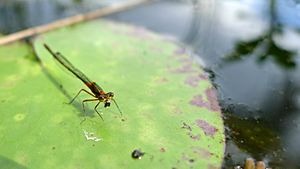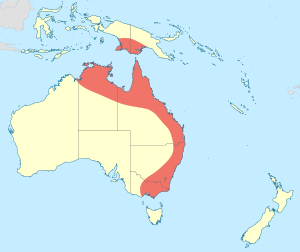Austrocnemis facts for kids
Quick facts for kids Austrocnemis |
|
|---|---|
 |
|
| A close-up of a Austrocnemis splendida damselfly. | |
| Scientific classification |
|
| Kingdom: | Animalia |
| Phylum: | Arthropoda |
| Class: | Insecta |
| Order: | Odonata |
| Suborder: | Zygoptera |
| Family: | Coenagrionidae |
| Genus: | Austrocnemis Tillyard, 1913 |
 |
|
Austrocnemis is a group of small, flying insects called damselflies. They are part of the family called Coenagrionidae. These damselflies are known for being tiny and having a bronze-black color. They also have very long legs, which is why they are sometimes called "Longlegs."
You can find Austrocnemis damselflies in places like New Guinea and Australia. They often live near water, where they can find food and lay their eggs.
Contents
What Are Damselflies?
Damselflies are insects that look a lot like dragonflies. However, there are a few key differences. When a damselfly rests, its wings are usually folded together over its back. Dragonflies, on the other hand, usually rest with their wings spread out flat. Damselflies also tend to be smaller and have thinner bodies than dragonflies.
These insects are part of an ancient group called Odonata. They have been flying around for millions of years! They are important predators in their habitats, helping to control populations of smaller insects.
Where Do Austrocnemis Damselflies Live?
Austrocnemis damselflies prefer warm climates. They are found in parts of Australia, especially in the northern and eastern regions. They also live on the island of New Guinea. These damselflies typically live near freshwater sources. This includes places like slow-moving streams, ponds, and swamps. They need water for their young to grow.
The areas where they live often have lots of plants. These plants provide places for the damselflies to rest. They also offer shelter from predators. The long legs of Austrocnemis might help them perch on thin stems or leaves.
What Do Austrocnemis Damselflies Eat?
Like all damselflies, Austrocnemis species are predators. This means they hunt and eat other smaller insects. They are very good at catching their prey while flying. Their diet mainly consists of tiny flying insects. This can include gnats, mosquitoes, and small flies.
Damselflies have excellent eyesight. Their large compound eyes help them spot their prey from a distance. They use their strong legs to grab insects out of the air. This makes them important for keeping insect populations balanced in their ecosystems.
Life Cycle of a Damselfly
The life cycle of Austrocnemis damselflies, like other damselflies, has three main stages: egg, nymph, and adult.
- Eggs: Adult female damselflies lay their eggs in or near water. They often place them on underwater plants.
- Nymphs: Once the eggs hatch, tiny young damselflies called nymphs emerge. These nymphs live underwater. They breathe using gills and are also predators. They eat small aquatic insects and larvae. Nymphs will molt (shed their skin) several times as they grow.
- Adults: When a nymph is fully grown, it crawls out of the water. It then sheds its skin one last time. This is when the adult damselfly emerges. The adult damselfly has wings and can fly. Its main job is to find a mate and lay eggs, starting the cycle again.
Species of Austrocnemis
The Austrocnemis group includes a few different kinds of damselflies. Scientists study these species to understand them better. Here are the known species:
- Austrocnemis maccullochi (Tillyard, 1926)
- Austrocnemis obscura Theischinger & Watson, 1991
- Austrocnemis splendida (Martin, 1901)
Each of these species has slightly different features or habitats. Scientists like Robert John Tillyard have helped identify and name many of these insects.
See Also
 In Spanish: Austrocnemis para niños
In Spanish: Austrocnemis para niños

